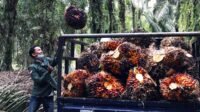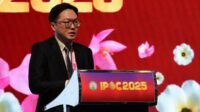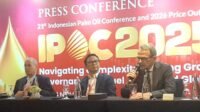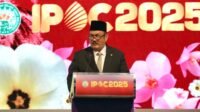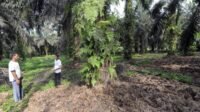PALMOILMAGAZINE, JAKARTA – The Indonesian government has officially issued Government Regulation (PP) No. 45 of 2025 on September 19, 2025. The regulation amends PP No. 24 of 2021 concerning administrative sanctions in the forestry sector. Initially, the regulation was expected to provide a legal pathway for millions of hectares of oil palm plantations operating in forest areas without permits. By imposing fines, businesses were supposed to gain legal certainty.
Instead, the new policy has sparked deeper uncertainty, raising fears that it could threaten the survival of Indonesia’s palm oil industry.
Muhamad Zainal Arifin, Director of the Center for Natural Resources Law Studies and Advocacy (PUSTAKA ALAM), described the legal land issue as a “time bomb” dating back to the deregulation era of the 1990s, when plantation permits often overlapped with forest areas that had not yet been officially designated.
Also Read:
“PP 45/2025 should have offered a fair settlement. Instead, it takes a shortcut that sacrifices business certainty and agrarian rights,” Zainal said in an official statement received by Palmoilmagazine.com on Sunday (September 28, 2025).
A Shift in Legal Philosophy
According to Zainal, the regulation represents a fundamental shift in legal philosophy. The Job Creation Law (Law No. 6/2023) emphasizes resolving land irregularities through administrative fines, not criminal sanctions, under the principle of ultimum remedium.
However, Article 3(5) and Article 35A of PP 45/2025 introduce a “land reversion” mechanism. After companies pay fines, their land is not automatically legalized; instead, it is seized by the state and handed over to state-owned enterprises (SOEs).
“This contradicts the very spirit of the Job Creation Law,” he stressed.
Another major concern lies in how fines are calculated. The Job Creation Law mandates that fines be based on profit margins, making them proportional. In contrast, PP 45/2025 sets a fixed rate of IDR 25 million per hectare per year.
Also Read: CPO Prices Edge Higher at KPBN on Wednesday (Oct 1), Bursa Malaysia Rebound After Three-Day Slump
As a result, fines balloon drastically. In some cases, what would amount to IDR 500 billion under the law could soar to IDR 2.5 trillion under the new regulation.
“This change erases fairness and creates extreme disparities,” said Zainal.
The situation becomes more problematic when the Forest Area Management Task Force (Satgas PKH) uses location permits—not actual cultivated land—as the basis for fines. In one case, a company with only three hectares of planted area was fined for 8,700 hectares.
Criticism has also been directed at the institutional framework. Under the Forestry Law and the Law on Prevention of Forest Destruction, authority rests with the Minister of Forestry. Yet PP 45/2025 strengthens the role of Satgas PKH, an ad hoc body.
“Now Satgas has the power to verify, recommend, and even execute land reversion. But this institution has no legal basis in existing laws. In effect, it becomes a shadow government,” Zainal added.
Looming Palm Oil Crisis
The harshest impact of the regulation concerns land rights. Indonesia’s Agrarian Law (UUPA) stipulates that plantation business rights (HGU) can only be revoked for public interest and with compensation. But under the new mechanism, HGUs could be revoked simply because the land is classified as forest—even at the preliminary designation stage.
This has already made financial institutions reluctant to provide credit to palm oil businesses, given the risk that land status could change overnight.
Other risks include a flood of lawsuits in administrative courts and rising agrarian conflicts in the field. From an economic perspective, the threat of disrupted CPO supply is significant. If productive land is transferred to SOEs, whose efficiency remains uncertain, Indonesia’s palm oil production could decline. This is concerning given that more than half of the world’s RSPO-certified palm oil comes from Indonesia.
By September 2025, Satgas PKH claimed to have taken back control of 3.3 million hectares of land. With fines set at IDR 25 million per hectare, companies collectively face obligations of around IDR 831 trillion. Observers warn this financial burden could cripple the palm oil industry, jeopardizing the livelihoods of 16.5 million workers.
Rather than serving as a solution, PP 45/2025 is increasingly perceived as a covert takeover tool—shifting the philosophy of fines from legalization to nationalization, imposing a rigid flat tariff, empowering an ad hoc task force, and undermining legal certainty.
“If not revised, PP 45/2025 could trigger a major crisis in Indonesia’s palm oil industry—a crisis of legality, finance, and social stability,” Zainal warned.
At a time when the sector already faces global pressure from environmental campaigns and trade boycotts, Indonesia’s palm oil industry now finds itself squeezed by its own domestic regulations. The outlook for the sector has rarely looked darker. (P2)





